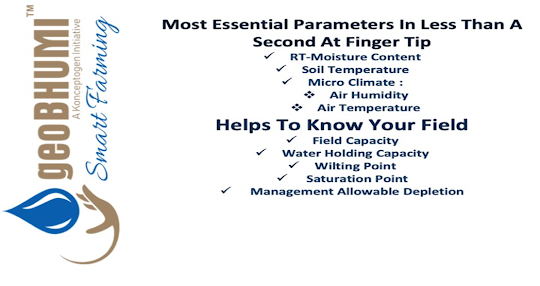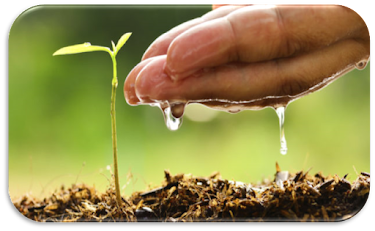Parameters of geoBHUMI.
vMost essential parameters in less than a second at fingertip.
The
farmers can access their field’s most important data like soil moisture, soil
temperature, air temperature and air humidity from anywhere from any corner of
the world with the help of a mobile phone in just a single click and no need to
go to field also.
ü RT- Moisture content:- Root zone moisture content
Soil moisture is the
water which is held in the spaces between soil particles, a good level of soil moisture helps in evapotranspiration, but if the plants soil has too much water the roots can rot and decreases
a plants ability to take up water through its roots. In saturated soil plants can’t
get enough oxygen from the soil , oxygen deficiency appears to most important
environmental factor causing stress, reduced growth, injury and death to trees in saturated
soils.
And if the soil don’t have enough water
soil gets wilted, the permanent wilting
point is the point when there is no water available to the plant. Wilting diminishes the plant's ability to transpire and grow. Permanent
wilting leads to plant death.
geoBHUMI can help to fix these problems. geoBHUMI is a device that can show the proper soil
moisture near to active root zone area. geoBHUMI will show moisture % with the
help of that farmers can access how much moisture is near to the active root
zone area. Then, farmers can decide if there is a necessity to irrigate more water.
If they get these questions answered they can definitely maintain proper
balance of moisture and surely avoid saturation and wilting point of soil.
By
maintaining moisture plants will get enough oxygen from soil it will
automatically affect for good growth of plants, quality and quantity of product
will increase and most important the device will reduce production cost.
ü Soil Temperature:-
Soil temperature is simply the measurement of the warmth in the soil. Plants will not grow and seeds will not germinate if the soil temperature is too low, and if soil temperature increases the crops or roots can affect with fungus or other diseases. Soil functions as a major storage mechanism of heat, collecting energy throughout the day and releasing heat to the surface during the night. Over the course of a year, soil retains energy during warmer seasons and releases heat to the air throughout colder seasons. Soil temperature directly affects plant growth. Soil temperature influences aeration, soil moisture content, and the availability of plant nutrients. Plants that are started in cold soils may grow slowly, develop poorly or succumb to the disease. Heat is the catalyst for many biological processes. When the soil temperature is low, certain nutrients are made unavailable or less available to plants. This is particularly true in the case of phosphorus, which is largely responsible for promoting the development of roots and fruit in plants. So, no heat = fewer nutrients = poor growth. That’s why measuring soil temperature is a very important role when plants are growing. Measuring soil temperature with the help of geoBHUMI will aid farmers to know normal or good soil temperature for plants. When soil temperature is controlled, the germination of seeds which affects the development of the plumule and the radicle when the plant grows, photosynthesis and respiration are influenced by the temperature of the soil which also influences the growth of roots and absorption of nutrients by them. Also with the help of good soil temperature, heat is reduced and it will help in good nutrients and automatically it will result in great growth of plants and productivity.
ü Micro climate :-
v Air Humidity :-
Humidity is the amount of water vapor in the air. If the humidity is too low, plant growth is often compromised as crops take much longer to obtain the saleable size. Also, lower leaves often drop off, growth is hard, and overall quality is not very good. Plants are always adjusting their leaf stomata openings based on the VPD (Vapor pressure deficit) and the humidity in the air. High humidity is a problem because water usage by the plant is too slow and compromises quality, even though the stomates are constantly open. Likewise, if humidity is very low and subsequent transpiration is too high, the plant closes its stomata openings to minimize water loss and wilting. Unfortunately, this also means photosynthesis is slowed and subsequently, so is plant growth. On the other hand, if the air is very humid the plant does not take up much water from the growing medium. That means the humidity is too high or too low and the loss of quality reduces the selling price of crops and increases production costs, both of which together reduce profits.
geoBHUMI will help to know the accurate Air humidity of the farmer’s field. Having knowledge of air humidity farmers can
manage and control it at a normal level. This way surely farmers can avoid harsh
situations like those mentioned above. Timely information about proper air
humidity through geoBHUMI, farmers can improve the quality of plants as well as
production.
v Air Temperature :-
Air temperature is a measure of how hot or cold the air is. The air temperature is a deciding factor in plant growth. Every crop has its own optimum, maximum and minimum temperature conditions for its growth and development. Some plants grow better in cooler temperatures, but some prefer warmer temperatures. The air temperature affects the amount of water a crop requires. Accumulated temperature is a weather parameter that directly influences the productivity of agricultural plants. Low air temperature affects photosynthesis. The growth rate of most plants increases as the temperature increases favorably. Air temperature regulates most plant processes such as germination, flowering, photosynthesis, transpiration and respiration. High air temperature generally increases the loss of moisture from the soil and from plants. High temperature, even for short period, affects crop growth and reduces the growth of shoots and root growth. High soil temperature is more crucial as damage to the roots is severe resulting in a substantial reduction in shoot growth.
The rate
of plant growth and development is dependent upon the
temperature. So measuring air temperature is very important. And geoBHUMI will help the
farmer to come out of this trouble by showing accurate air temperature.
vHelps
to know your field.
ü Field Capacity :-
Soils hold
different amounts of water depending on their texture and structure. The upper
limit of water storage is often called "field capacity" (FC), Field
capacity is water which is held by
soil when macro-pores have drained the water and micro-pores are still filled
with water. At
field capacity plants remove water easily from the soil. It is the amount of water that remains in the soil
after all the excess water at saturation has been drained out usually when sandy
soils are allowed to drain for approximately 24 hours after saturation, field
capacity is reached. In heavier textured soils that have more slit and clay, it
takes up to 2-3
days after saturation to reach field capacity.
The geoBHUMI device will help to know farmers’
field capacity with the help of accessing the soil moisture in the above parameters. Knowing
field capacity can help to determine
water irrigation.
ü Water holding capacity :-
Soil water holding
capacity is a term that all farms should know to optimize crop production.
Simply defined soil water holding capacity is the amount of
water that a given soil can hold for crop use. Field
capacity is the point where the soil water holding
capacity has reached its maximum for the entire field. The goal for
agricultural producers is to maintain the field at or near capacity. When there
is a deficit in the amount water in the soil, the soil profile needs to be
replenished by precipitation or irrigation. The key is for farmers to
understand the nuances of soil water holding capacity and how to manage it so
that the farm does not need to irrigate or suffer from a drought.
The water-holding capacity of soil is a very important
agronomic characteristic. Soils that hold generous amounts of water are less
subject to leaching losses of nutrients or soil-applied pesticides. This is true because soil with a
limited water-holding capacity (i.e. a sandy loam) reaches the saturation point
much sooner than soil with
a higher water-holding capacity (i.e. a clay loam). After the soil is saturated with water, all
of the excess water and some of the nutrients and pesticides that are in the
soil solution are leached downward in the soil.
The
geoBHUMI can help to know the soil’s water-holding capacity with the help of
knowing soil moisture. To avoid the above crisis farmers need to solve this problem. And
geoBHUMI’s accurate data can help to come out from these problems.
ü Wilting Point :-
When
plants take up all the available water a given soil, soil dries to a point that
is cant supply any water to keep plants from dying. If the soil water content
decreases to this or any lower point a plant wilts and can no longer recover
its turgidity when placed in saturated atmosphere for 12 hours. As
mentioned and the most well-known cause of wilting in plants, is a lack of
water. This coupled with high temperatures or extreme sunlight can really do
damage to a crop. A dry environment will pull moisture out of the plant and
insufficient water will prevent nutrients from reaching the ends of the plant.
Plants will generally recover when temperatures decline such as during the
night. Effective irrigation scheduling will keep plants hydrated and prevent
crop loss.
Farmers are tackling this big water issue and the most common
causes of wilt. geoBHUMI is helping growers to monitor the plant’s available water
through knowing the soil moisture . This device provides information to that
how much water is near to the root zone area and then farmers can decide how
much more water is required If farmers will manage the irrigation with the help
of geoBHUMI then definitely they will not face issues like wilting point of
soil and many more .
ü Saturation Point :-
It is the
soil water content where all soil pores are filled with water readily percolates or drains out from the
root by gravitational force. If soil remain saturated for too long , most
plants will decline or die .If there is a lot of water near to the plant’s root
then oxygen will be not available for plants . Growth and maintenance of root
systems require large quantities of oxygen for respiration. When oxygen content
drops below 10% root growth of most plants will be limited . Oxygen deficiency
appears to be the most important environmental factor causing stress, reduced
growth, injury and death to trees
and other plants in saturated soils. A saturated soil decreases a plant’s ability to take
up water through its roots.
This is one
more big water issue for farmers. The geoBHUMI device provides information to farmers that
how much water is near to the root zone area and then farmers can decide is
there necessary to give more water. If farmers will manage the irrigation with
the help of geoBHUMI then definitely they will not face issues like saturation of
soil and many more.
ü Management Allowable Depletion :-
Management
allowable depletion is usually expressed as a percentage of the total available
water capacity in the rooting zone. Management allowable depletion is the
lowest moisture level that
can be sustained by plants without adverse stress effects. This is the
moisture point at which irrigation should be initiated to avoid having stress
affect plant growth.





Comments
Post a Comment